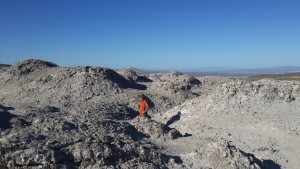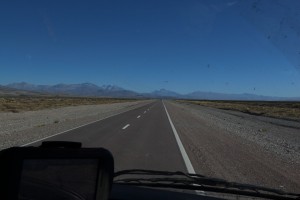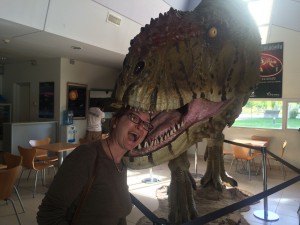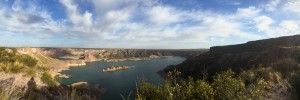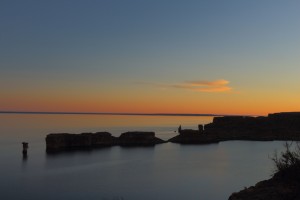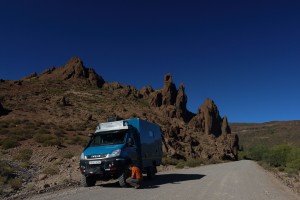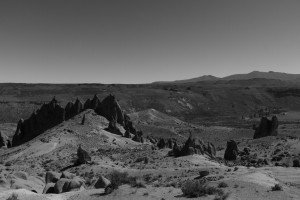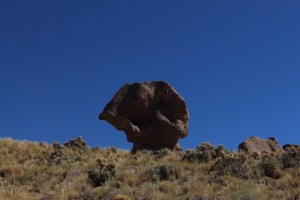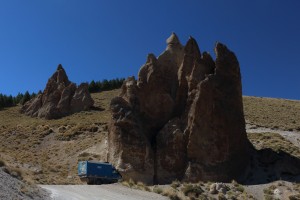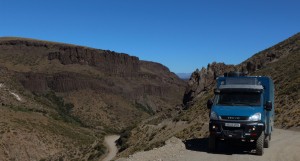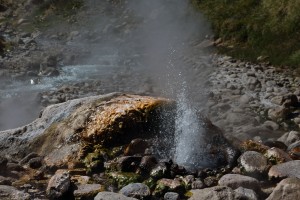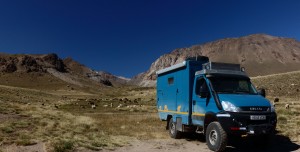Oh no! Not another view of snow-capped peaks, venting volcanos, aqua-marine mountain lakes set against a back-drop of clear blue skies (yawn 🙂 )! We hadn’t thought it possible to tire of southern Chile’s spectacular landscapes, but after weeks of relentless picturesque mountain views appearing around every bend, we were itching for a change of scene. We have now scientifically proven that you can indeed have too much of a good thing (provided of course that the relevant ‘good thing’ isn’t chocolate – you can obviously never have too much chocolate).
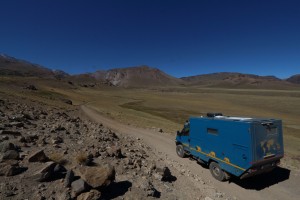 A change of scene
A change of scene
Amazingly, a drive of just 80 km to the Argentinian eastern side of the Andes provides the sought-after change of scene. The mountains provide such a climactic barrier that the weather fronts drifting in off the Pacific drop most of their water onto Chile, before the warmer, drier winds continue over the top and down the other side to Argentina. Once you drop down from the high mountains on the Argentinian side, you are back on the edge of the pampas. Ahhh…! The environment is drier, the landscape more barren.
As we cross back into Argentina… what’s changed since we were last here over seven weeks ago? We have seen on the internet that the policies of the new government are having a couple of significant impacts on overland travellers. First, currency. Regular Cuthbert followers may remember our spiel about the Peso and the Blue Dollar. The issue appeared to be resolved by President Macri removing the currency controls when he took office in December, but the knock-on effect now seems to be the banks’ reluctance to issue currency from cash-points to holders of foreign credit/debit cards. Presumably they preferred it when foreigners brought hard currency US $ bills into the country and exchanged them at ‘undisclosed locations’ for Pesos. We have read of European and Australian travellers being ‘stranded’ in a few key tourist centres, unable to obtain any Pesos with the credit/debit cards on which they rely for a flow of cash from home. However, we have also heard that it is quite easy to exchange Chilean Pesos at a reasonable rate, so in anticipation of Argentinian ATMs not ‘doing-the-do’, we have brought sufficient Chilean Pesos to keep us in chocolate and wine for a while.
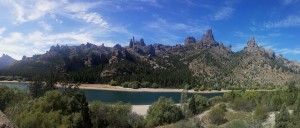 Another thing we have read about is the current erratic supply of fuel to petrol pumps in some areas. Smaller towns and rural areas in particular are apparently being overlooked in the supply-chain and there are long queues at the filling stations whenever a tanker arrives. To deal with this we filled Cuthbert to the gunnels before leaving Chile – a total of 400 litres gives us a range of around 2,500 km. Fuel is also far cheaper in Chile than in Argentina (a saving of around £120 when filling all three of Cuthbert’s tanks), so it makes sense to fill-up in Chile anyway.
Another thing we have read about is the current erratic supply of fuel to petrol pumps in some areas. Smaller towns and rural areas in particular are apparently being overlooked in the supply-chain and there are long queues at the filling stations whenever a tanker arrives. To deal with this we filled Cuthbert to the gunnels before leaving Chile – a total of 400 litres gives us a range of around 2,500 km. Fuel is also far cheaper in Chile than in Argentina (a saving of around £120 when filling all three of Cuthbert’s tanks), so it makes sense to fill-up in Chile anyway.
But some things never change in Argentina. Just in case it has slipped the mind of anyone entering the country, the ‘Las Malvinas son Argentinas’ message is regularly signposted. And on a more serious note… shockingly, unlike in Chile, Argentina’s supermarkets still don’t sell natural, unsweetened yoghurt (I know…! An outrage isn’t it? 🙂 ). But on the plus side they do stock delicious fresh milk, compared to Chile where only long-life carton milk is available.
Anyway… we’re on the road, re-joining Ruta 40 and heading north. This section of the Route 40 is tarred, so we shouldn’t have any repetition of the mud story that we had further south. The road more or less forms the line where the Andes mountains meet the pampas plains, which makes for an ever-changing view as we settle down in Cuthbert to cover a bit of distance.
Dinosaur Day
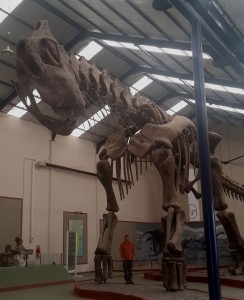
Marcus and Denise the Dinosaur
We skipped fairly quickly through the Argentinian Lake District (not that we have anything against Bariloche and San Martín you understand, they’re perfectly nice, but we’re done with the ‘mountains and lakes thing’ for the time being, remember?) and headed 300 km north to visit a Mr & Mrs Dinosaur in one of the worlds paleo-hotspots, Neuquen.
For the convenience of palaeontologists of the 20th and 21st centuries, several dinosaurs considerately chose to deposit their bones in the Neuquen area and there are a few sites of interest to members of Denis the Dinosaur’s fan-base. Most travel literature on the Neuquen area is still full of the region’s once legitimate claims to host the remains of the world’s two largest known dinosaurs. Unfortunately, the ‘World’s Largest Dinosaur’ crown has very recently been knocked-off Neuquen’s head by a young, up-start paleolithic site found south of here in Patagonia less than two years ago. Last year as we headed south through Patagonia, we drove fairly close to this new site near Trelew, totally oblivious to the exciting findings going on there at the time. We’re disappointed to have missed this new pretender to the throne of ‘world’s largest dinosaur’ (obviously not that disappointed, otherwise we would now be driving 600km back in the opposite direction to see it!) but we are nevertheless still keen to see the Neuquen sites of the world’s now second and third largest dinosaurs.
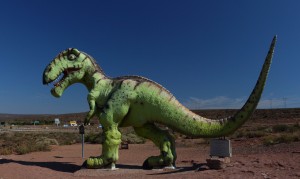
Cheesy intro to the Paleo-hotspot
First we visited the site of the Giganotosaurus Carolinii; we named him Denis, for short. About 80% of Denis’ skeleton was found in 1993 and is on display – he is around 100 million years old (give or take the odd million). We found it fascinating to contemplate how those very bones right in front of us have survived so long. In his younger days, Denis was a stocky chap: 14 metres long and weighing over 8 tons – that’s bigger than the better known Tyrannosaurus-Rex.
At the next site we visited the Argentinosaurus Huinculensis, but in the interests of 21st Century gender equality, we called her Denise. Denise is in fact, substantially larger than Denis, measuring 40 metres long and around 18 metres high. Unfortunately, rather less of Denise was found, so her ‘complete’ skeleton on display in the museum is largely a replica. Nevertheless, standing next to the bones and looking up at a dinosaur head some 18 metres above, makes one rather grateful not to have been around in the days when Denis and Denise hosted cocktail parties around here.
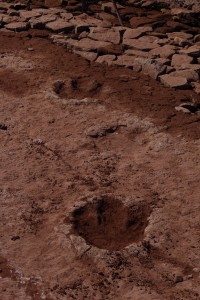
Denis was here
Another site we visited was to see some dinosaur’s footprints – actual imprints formed in the rocks. We had seen examples of these on our previous travels in Namibia so we thought we knew what to expect. However, it is perhaps a sign of the quality of this Argentinian ‘dino-footprint experience’ that there is no charge to see them. Only two of the footprints are sufficiently distinct to clearly make out what they are; for the rest of them you need a bit of imagination! Nevertheless, we had an interesting Dinosaur Day with Denis and Denise and are charmed to have made their acquaintance.
Getting into hot water
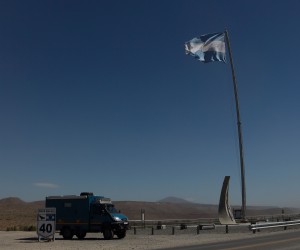
Chos Malal – halfway point on Ruta 40
Next we just popped a few hundred kilometres north up Ruta 40 (distances are big in Argentina!) towards our next target destination – the hot springs of Aguas Calientes. On the way we passed through the small town of Chos Malal at which sits the half-way marker for Ruta 40; so we are now half way up Argentina’s iconic equivalent of the USA’s Route 66. To be honest, we haven’t done Ruta 40 all the way up this far; we did a bit of a detour into Chile to do 1,000 km northbound on the Carretera Austral instead. Sshhhh….! No-one will notice that we missed a bit 😉
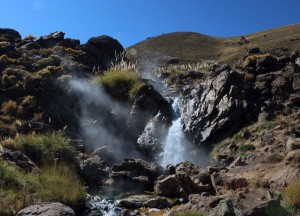
Not smudges on the lens – a steamy stream
Anyway, as we said, we were heading to Aguas Calientes to the hot-springs. These are said in the travel books to be a bit remote and set in a beautiful landscape, but the write-ups didn’t prepare us for quite how awesomely amaze-balls the scenery is. The drive is around 150 km off Ruta 40. The first 100km is conventionally pleasant enough, but then starts the fascinating geology, geysers, bubbling hot-water streams and steep narrow tracks snaking through the rock-scapes. We are not short on experience of driving through scenic landscapes, but the stretch from the village of Varvaro to Aguas Calientes is right up there as one of our favourite drives of all time. Our good fortune with the weather made it particularly splendid, added to the fact that it is ‘shoulder season’ so we saw just two other vehicles over the whole route (sooooo pleased we got here before the Easter holiday crowd arrive next week 🙂 ).
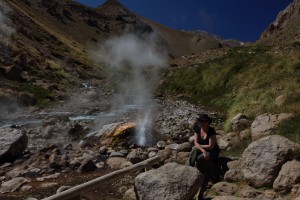 Dotted around the landscape are steam vents and bubbling-hot water gurgling and spurting out of the ground. Hiking around the hills we found a fast-flowing stream with deep pools tumbling over rocks in a series of drop-dead gorgeous waterfalls. We sped towards it, keen to jump in for a bit of natural jacuzzi, but it was just too damn hot! Even approaching from a couple of metres down-wind was like putting your face in front of boiling kettle. Further down-stream the geyser water had had chance to cool down and we were able to dunk-in for a wallow in the soothingly warm waters at sunset. The only challenge was to find rocks to hold onto to avoid being washed away by the strong current!
Dotted around the landscape are steam vents and bubbling-hot water gurgling and spurting out of the ground. Hiking around the hills we found a fast-flowing stream with deep pools tumbling over rocks in a series of drop-dead gorgeous waterfalls. We sped towards it, keen to jump in for a bit of natural jacuzzi, but it was just too damn hot! Even approaching from a couple of metres down-wind was like putting your face in front of boiling kettle. Further down-stream the geyser water had had chance to cool down and we were able to dunk-in for a wallow in the soothingly warm waters at sunset. The only challenge was to find rocks to hold onto to avoid being washed away by the strong current! 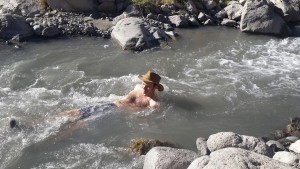
Our only disappointment with the Aguas Calientes area is that our photographic attempts don’t quite capture the full marvel of the place – so you’ll just have to pop over and see for yourselves one day!
DIY road
After the marvellous Aguas Calientes, we decided to try a possible dirt-track route to the north, to rejoin the Ruta 40 at Barrancas. Note: ‘possible’ because although the track is clear on two of our paper maps, it doesn’t appear on our sat-nav. Hmmm… would the track go through? The alternative was to back-track around 150km to Chos Malal to re-join Ruta 40 where we left it a few days ago to the south. Taking a ‘glass half-full’ type of approach here, we decided to give the northerly track a try.
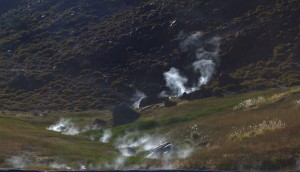
Steaming river
The track soon started to deteriorate quite badly but it had obviously been driven fairly recently, so Cuthbert soldiered on. It took us down a pretty river valley, past a few deserted goat farms and some distant gauchos on horseback out with their herds. Then after ages of slow, rough-going track we went off the end of the sat-nav route and started creating our own GPS track across the sat-nav screen. We could see to the end of the valley in the distance where we hoped we would join another road shown on the sat-nav, but we couldn’t see whether our track would actually take us there. Surely it must go through… mustn’t it?
The track got rougher and narrower and there were some precarious looking soft-crumbly edges on the side of the track dropping down to the river. We held our breath and continued until we reached a landslide and some boulders partially blocking the track. Tyre marks indicated that at least one smaller vehicle had managed to squeeze past the obstructions, but we weren’t 100% confident that Cuthbert would fit around the rocks. We could possibly have driven one side of Cuthbert over the debris, but this would have put the axles at an angle generating a concerning roll to the left, with Cuthbert leaning precariously over the drop to the river 10-15 metres below. At this point a small difference of opinion arose, with Marcus unsuccessfully trying to persuade the more sensible of the two of us to give it a try. We did however share a sense of frustration and agreed on a highly scientific guess-timation that we were probably only 5 or 6 km from the road which we were aiming to join!
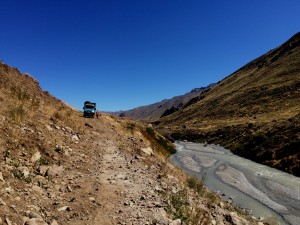
Getting a bit narrow for Cuthbert
We sat for a while contemplating how much work it would take to move the landslide debris off the track; probably several hours of back-breaking shovelling in the hot sun, plus some time with the winch to drag the boulders out of the way. Then we wondered… if we did get past this section, what might come next? So we took a walk some distance down the track to investigate whether it would: a) get even worse; and b) take us to the road that we wanted to join.
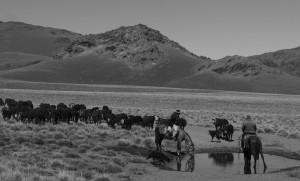 The time invested in this walk ahead down the track paid generous dividends. Turns out that the track went down to the edge of the river. The river was quite wide and fast flowing, but didn’t look too deep – probably within Cuthbert’s wading depth. There was evidence of another vehicle having forded the river, with tyre tracks either side of the ‘crossing’, but the deal-breaker was the dirt-ramp out of the river on the other side. It looked fine from some angles, but a side-on inspection showed that the river had washed the bank away from underneath half of the track; the road-surface above the void was only a few inches thick! Yet more impromptu civil engineering would be required. The only way to drive Cuthbert out of the riverbed on the other side would have been to dig away the bank on the solid side of the road, to widen the track where the ground was solid beneath. And even if we did that, we still didn’t know for sure that the track took us where we wanted to go! The conversation between us went something like: “What if we dig…” “No”. “But what about…” “No”. “But we could just…” “No”. No prizes for guessing which of us was making the suggestions and which of us was (prudently) batting them off J. In the end common sense prevailed and, as our Wallace and Grommit sat-nav voice said: “Don’t be sheepish… make a ewwwwe-turn, and enjoy this fine stretch of road… again!”
The time invested in this walk ahead down the track paid generous dividends. Turns out that the track went down to the edge of the river. The river was quite wide and fast flowing, but didn’t look too deep – probably within Cuthbert’s wading depth. There was evidence of another vehicle having forded the river, with tyre tracks either side of the ‘crossing’, but the deal-breaker was the dirt-ramp out of the river on the other side. It looked fine from some angles, but a side-on inspection showed that the river had washed the bank away from underneath half of the track; the road-surface above the void was only a few inches thick! Yet more impromptu civil engineering would be required. The only way to drive Cuthbert out of the riverbed on the other side would have been to dig away the bank on the solid side of the road, to widen the track where the ground was solid beneath. And even if we did that, we still didn’t know for sure that the track took us where we wanted to go! The conversation between us went something like: “What if we dig…” “No”. “But what about…” “No”. “But we could just…” “No”. No prizes for guessing which of us was making the suggestions and which of us was (prudently) batting them off J. In the end common sense prevailed and, as our Wallace and Grommit sat-nav voice said: “Don’t be sheepish… make a ewwwwe-turn, and enjoy this fine stretch of road… again!”
Space Town
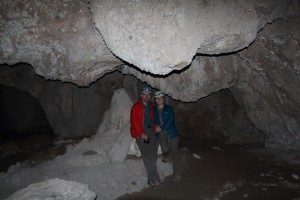 Skip forward a few days, we have had a slow and pleasant drive further on Ruta 40 up the Rio Grande valley with some lovely riverside wild-camps. We stopped to see the allegedly impressive Cavernas de las Brujas (Witches’ Caverns) at Bardas Blancas, but the tickets for the best section of the caves were booked up and we could only see the less than impressive entry chamber to the underground network. We hope that we gave a suitably enthusiastic reaction of amazement when the guide pointed out a frankly, undecipherable image of witches and Jesus in the wall of the cave. It didn’t bother us greatly as we were looking forward to arriving next in Argentina’s ‘space town’.
Skip forward a few days, we have had a slow and pleasant drive further on Ruta 40 up the Rio Grande valley with some lovely riverside wild-camps. We stopped to see the allegedly impressive Cavernas de las Brujas (Witches’ Caverns) at Bardas Blancas, but the tickets for the best section of the caves were booked up and we could only see the less than impressive entry chamber to the underground network. We hope that we gave a suitably enthusiastic reaction of amazement when the guide pointed out a frankly, undecipherable image of witches and Jesus in the wall of the cave. It didn’t bother us greatly as we were looking forward to arriving next in Argentina’s ‘space town’.
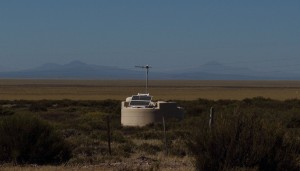
Cosmic ray catcher
Malargϋe is a small town sat neatly in the sparsely populated area between the pampas and the Andes. It apparently has one of the clearest skies on the planet for observing the stars (so that’s why we haven’t seen many of those fluffy-cloud-things recently!). It is home to the Pierre Auger Observatory at which scientists of 17 nations collaborate to measure and study cosmic rays entering the earth’s atmosphere from space (amusingly, the flags of only 16 nations are displayed outside the building; the Argentinian hosts can’t quite bring themselves to hoist a Union Jack 🙂 ). There is an area of the observatory set aside for public education on the project, but as we approached the building it looked less than ‘observatory-like’ – no Jodrell Bank-style great domes, dishes or antennae facing up to the stars. Our hopes weren’t high as we went in, but we were soon enlightened by an interesting display explaining that their data for analysis is gathered from a huge network of sensors scattered over thousands of square meters across the pampas to the north of the town. We were particularly impressed that not only was the display in Spanish and English (very unusual in South America), the receptionist offered to fetch one of the English speaking research scientists to talk to us if we had any technical questions about the project. We declined the kind offer of this service as we couldn’t think of anything intelligent to ask!
Also following the ‘space’ theme, Malargϋe has a planetarium which we were also keen to visit. This was another impressive facility, with daily shows about various space-topics. The projections were really great, but the narration on the formation of Black Holes tested my Spanish to the limit! Where is Professor Brian Cox when you need him? 🙂 Nevertheless, we got the gist of it all and were impressed that they delivered a genuinely informative programme, not simply a whizzy show of visual effects (a charge which we would make against the London Planetarium last time we went there).
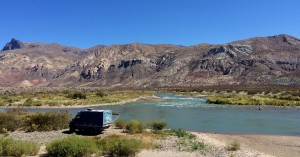
Anyway chums… it’s nearly Easter and the schools are on holiday again. We should probably be rather ashamed to admit that we sometimes resent these public holiday things. How dare all these ‘normal’ people leave their jobs and come out to the countryside to spoil our peaceful overlanding lifestyle??? :-0 So whilst the city-dwellers enjoy a no-doubt well-earned Easter break in the mountains, we are heading to the city of Mendoza in the Argentinian winelands. Looking forward to some nice architecture and museums, some nice street cafes and maybe even an opportunity or two sampling the wares of the regional vinyards. Happy Easter to everyone. Next blog will follow when we have recovered from the vino 😉
PS: Thanks to Cuthbert Blog reader Thomas Alf who wrote and sent us a Limerick for Cuthbert following our last blog-post. Cheers Thomas! Your requested rights fee of red wine, cheese and French bread is in the post! 🙂
Link to next blog: Wine and High Peaks Link to full South America Blog


